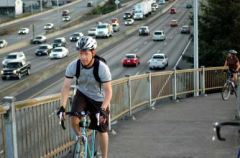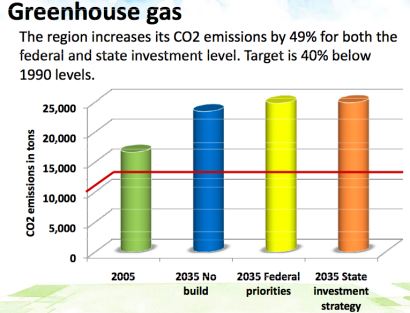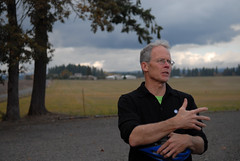
their transportation plan.
(Photo © J. Maus)
Metro’s update to the 2035 Regional Transportation Plan (RTP) — which will guide $20 billion of investments in our regional transportation infrastructure over the next 25 years — is coming under fire from advocacy groups, Portland Mayor Sam Adams, and others.
Among Metro’s stated goals for the plan are to create an “efficient urban design”, “expand transportation choices”, “enhance safety”, and “reduce pollution”. But critics of the plan say it falls short in the key metric of reducing greenhouse gas emissions (34% of Oregon’s emissions come from transportation) and that it invests too much on highway widening and road projects. Metro Councilor and RTP point man Rex Burkholder stands behind the plan
In total, 659 projects totaling $19.4 billion dollars were submitted and have been included in the draft RTP.
The Bicycle Transportation Alliance (BTA) has come out against the plan, saying in official comments and on their blog that it is “not sufficient towards changing the overall reliance on automobiles and the associated consequences.”
The BTA also pointed out a finding from Metro’s own analysis showing that “the region would get closer to meeting greenhouse gas emission goals by not building out the RTP project list.”

The non-profit Coalition for a Livable Future (CLF) puts a sharper point on their criticisms of the plan. They issued a detailed critique (PDF here) headlined by the claim that the RTP would “increase global warming pollution by 50%”. CLF’s disappointment caught the attention of the Willamette Week newspaper, who gave Metro a “Rogue of the Week” award at the end of October.
“I can’t support the RTP in its current form.”
— Sam Adams, Mayor of Portland
Biking and environmental advocates aren’t the only ones questioning the RTP.
Portland Planning Commissioner, citizen activist, and all-around transportation thinker Chris Smith wonders if it’s “time to reboot the RTP.” And Portland Mayor Sam Adams, in a meeting last week of a Metro transportation policy advisory committee said, “I can’t support the RTP in its current form.”
So, what’s going on with Metro’s plan? Why is it attracting so much rancor from sustainable transportation advocates and others? I asked Rex Burkholder what he makes of these criticisms.
Is it time to scrap the plan and start over? Far from it says Burkholder:
“Scrapping all the work done, especially the adoption of new policies and performance targets, as is called for in the Portland Transport Article, is just silly rhetoric.”
Burkholder acknowledges that the plan isn’t perfect, but adds that the problem is with outdated modeling methods and the task of changing an entrenched transportation planning mindset — not on Metro itself.
“Do I wish we could have gone farther? Of course. But this is a dance with many partners, or to mix metaphors, a giant ship that we are turning.”
— Rex Burkholder, Metro Councilor
“We are limited by existing models that were developed to model pollutants like CO and Ozone, not CO2. They do the former well but we aren’t very happy with how the CO2 modeling performed.”
Burkholder also laments models used in the RTP don’t account for biking or walking. “We don’t actually model biking or walking yet… Without actually being able to predict future walking and cycling rates, the models show higher car use than is likely, ergo, more carbon emitted.. this is also why the numbers for future cycling and walking are disappointing. ”
As an example, Burkholder said that modeling of the traffic on SW Broadway would have showed more motor vehicle traffic with the installation of a cycle track. But, Burkholder says, “It had to be done on faith because the right models don’t exist.”
Metro is currently working with Portland State University on a new modeling tool that will be used in the next RTP update.
One of the key criticisms made by the CLF is that Washington County’s list of projects in the RTP shows they’re “trying to build their way out of congestion”. Burkholder responds by saying Metro’s plan must account for an influx of 600,000 new residents and that, “The reality is more people will require more transportation facilities.”
And those transportation facilities, according to Burkholder, must be well-connected, requiring new roads to be built.
“Because you’re building cities, you need infrastructure to provide access for all the new development that’s going on. They’re [the streets] are multi-modal and you can design them well. Think about Washington and Clackamas Counties, a big chunk of their roads are isolated. We have connectivity standards; in new areas you have to have a minimum of 16 connections per mile. That’s what we’re trying to do.”
Burkholder maintains that the proposed road projects in the RTP “are community building projects” and that the idea is to create the type of dense grids present in East Portland — the same type of grids that facilitate walking and biking. And those roads, says Burkholder, come with policies and guidelines that require them to be complete streets.
“The street guidelines are in place. If you don’t believe they will have the desired result than… it takes vigilance [to make sure those guidelines are followed] but it doesn’t mean the plan is lacking.”
Burkholder also points out that the RTP only reflects projects and expenditures eligible for federal funding. One criticism from the BTA was that not enough was going into maintenance. But maintenance, says Burkholder, is locally funded.
Even while standing up for the RTP and rebuffing some criticisms, Burkholder acknowledges that it could be different. “Do I wish we could have gone farther? Of course. But this is a dance with many partners, or to mix metaphors, a giant ship that we are turning.”
When asked if people are warranted in saying the RTP should be more bold, Burkholder reponded,
“I think our policies are very bold. We’re one of the first to have an outcomes-based planning model using real performance measures, using real traffic counts, looking at environmental health. It’s not easy, that’s why it’s incremental. It is bold, but to translate into making change on the ground takes time. Things are moving in the right direction.”
Metro staff will complete this RTP update in early 2010 and open a 45-day public comment period on the document in April prior it going up for a vote by Metro Council in June.







Thanks for reading.
BikePortland has served this community with independent community journalism since 2005. We rely on subscriptions from readers like you to survive. Your financial support is vital in keeping this valuable resource alive and well.
Please subscribe today to strengthen and expand our work.
I could be wrong, but I think Burkholder supported the $4,000,000,000 scheme for the CRC just because he didn’t want all the research/work done thus far to be wasted.
It sounds like the same thing is happening here. If it’s an ineffective plan, then it’s an ineffective plan. Why institute something that will not work? Then he seems to shrug his shoulders and hide behind his “dance partners”. Oh okay.
I lost confidence in Burkholter when he supported the 12-lane Columbia River Crossing project.
He seemed to have been rolled by the road construction industrial complex in that one. Is it happening again?
Many of the RTP projects widen roads and add lanes rather than increase street connectivity, particularly in Washington County where 5-lane roads and double left turns are business as usual. These type of “improvements” effectively preclude viable bike and ped travel.
Just a reminder that Bob Stacey is running against Rex for Metro President next year. His positions on the CRC and RTP have already won him my vote. How about an interview with him, Jonathan?
https://www.bobstacey.com
ditto Andrew #4 – a Bob Stacey interview would be great.
As much as it pains me to say it, given Rex’s bona fides in starting the BTA back in the day, I think Bob is the better choice. He didn’t drink the CRC kool-aid, and after many years with 1,000 Friends of Oregon he knows the transportation /land use dance steps as well as anyone.
Rex still supports the CRC.
Read the CLF critique linked to in the story above. It is really good, and I don’t think unfair or unbalanced.
JR: Many of the Washington County projects are 7 lane expansions!
Yes, Burkholder did support the 12 lane CRC and that’s when I lost confidence in him as well.
Let’s retire Rex. The sooner the better. Shame on him.
it’s a shame that people are looking at one project (albeit a big one) to form their opinions about an elected position that has so much more responsibilities than transportation. Metro is but one of eigth entities that are asked to weigh in this thing. Stacy or Burkholder will have FAR more things to deal with as Metro president. So if Rex would have supported 10 lanes, would you have been for or against him? You don’t really know, now do you? Best to educate yourselves about what else the person in this job handles besides build bike lanes and bridges. Cyclists are losing steam, relevance and important jobs – Bricker’s canning had quite a bit to do with the BTA kids actions on CRC.
KJ, whoever told you that a condescending tone will win people to your side of a debate wasn’t steering you right.
No, I would not have supported a 10-lane CRC (nor any permutation without tolls, without light rail, and with bike facilities under the auto-deck). That Burkholter signed on to such a monumental monstrosity calls into question his judgement and/or his ability to stand up to a roomful of monied interests who are trying to stampede him. Either way, it shows he lacks some things that I look for in a Metro executive.
I don’t think it’s accurate to call the BTA “kids”. Mary Roberts looks like an adult to me. And I support their pulling out of the CRC process once they found that their input was being systematically ignored. When you find yourself in a process with institutions that are only interested in having you around for window-dressing, the effective thing to do is to excuse yourself from it and bring your criticisms to the wider world.
Finally, I don’t know what city you live in, but in Portland bicyclists are more relevant and powerful than at any time since I moved here 11 years ago. Avoiding being co-opted will only help us continue to grow as a political force.
Bob Stacey’s rss feed icons don’t work. And he has no email address. 🙁
i’m thinking that any transportation plan should essentially be a ‘no build’ plan with respect to roads. no roadways should be expanded, and no new ones should be created. if you want to plan for new housing/development/etc., then you’d better integrate non-car transportation options, because there will only be small streets and roads available, they’ll be shared by pedestrians and bikers and trucks and cars and everything else. new neighborhoods will have to connect to the existing overbuilt road network.
i really think that’s the mindset we, and our models, need to have — no new or expanded roadways. the models need to weigh new or expanded roadways as ‘basically impossible’ — equivalent right now, probably, to what the models think of the possibility of creating new rail lines/stations/etc.
should we build new rail? sure. new bike paths? sure. new roads? no. except in the case where they need to be connected to the existing road network, and only then, if there are absolutely, positively, no other options. we’ll build no new arteries or highways or anything crazy like that.
now i’m curious how the existing models work. 600,000 new people means….what? a dozen new highways and bridges? does it ever mean more trains? or bike paths?
and existing models don’t take into account bikes at all?
sometimes the stuff i read doesn’t seem real. am i just asleep right now? a long-term planning document which doesn’t factor in cycling? why not just take out breathing, too?
Building some roads to increase connectivity in suburban areas makes a lot of sense to me – I really believe that will improve the chances of people in those areas choosing to walk and bike places. Sidewalks on existing roads would also be fantastic. Walking or riding in the gravel shoulder on a 2-lane road with no stops and a 30-40mph speed limit is not fun, but that kind of stuff exists all over the outer parts of the city. Even worse if there is only one road choice, and it takes you way out of the way from where you need to go, which is also the case in many suburban areas.
Building new arterials, highways, etc seems like something we should be *extremely* reluctant to do at this point. We have a workable highway system in place, and we want to shift people away from using them so much anyway. Perhaps increasing congestion, combined with better local development in suburban areas, will eventually convince people there are better ways to go.
In general, it seems that if we want to encourage people to change transportation behavior, we need to slow way down on expanding the mode we want to discourage, and speed up on expanding the ones we want to encourage.
Unless we’re just giving lip service to the idea.
Hi, Josef —
First, I’ve worked with the BTA long enough to strongly second what you say: the BTA aren’t “kids.”
Let me respectfully correct you, however, that Rex was and is a strong and early advocate for light rail, tolling, and bike/ped on the bridge — to crowbar those into the package is probably the reason he waded into the CRC morass in the first place. In June 2008, here’s what the “Task Force” he and 38 other people (including Sam Adams) were a part of recommended to the powers that be at ODOT and WASHDOT (PDF, but not very large).
See page 2, #2: “In regards to the high capacity transit selection, the CRC Task Force supports light rail as the preferred mode.” And later, “The development of light rail stations that meet the highest standards for operations and design.”
Page 4, near the bottom: “Imposing tolls on the existing I-5 bridge as soon as legally and practically permissible to reduce congestion by managing travel demand as well as to provide an ongoing funding source for the project.
Page 5, near the top: “Continued development of a “world class” bicycle, pedestrian facility…”
What’s also interesting is page 2, #1: The group supported the “construction of a replacement bridge with three through lanes northbound and southbound as the preferred option” – that is, 6 lanes. Above that, it appears to have been ODOT/WASHDOT’s call. See page 4, bullet 3: “Further study and analysis to determine the appropriate number of auxiliary lanes, necessary for safety and functionality in the project area, and consistent with minimizing impacts.”
btw, Jonathan asked a lot of great questions about the CRC in an interview with Rex about a year ago.
Wait. If “the idea is to create the type of dense grids present in East Portland”, then we’re doing it wrong. The grids in east Portland are not dense. I can see how they might seem dense because the blocks are are short but I don’t think anybody would consider that area “dense” in the sense of urban density. It’s not an urban area. It’s an area of sprawl, of detached single-family houses and strip malls. If the goal is an active, sustainable, and humane city, then the idea should be to focus on creating real density and not on enabling sprawl. Rex is wrong.
josef (#11) – spot on.
Great coverage Jonathon.
It would be fabulous to eventually have side-by-side interviews with both Stacey and Burkholder that could cover a range of issues relevant to bikeportland readers (although the decisions around the Regional Transportation Plan (RTP) are probably a good thing to focus in this regard).
One thing to keep in mind regarding regional governance and the Metro Council. The Metro Council has more authority than it decides to exercise in most cases. However, in practice, critical regional growth management decisions are really made by key Metro committees largely made up of local elected officials: specifically the Metropolitan Policy Advisory Committee (MPAC) and the Joint Policy Advisory Committee (JPAC). While the Metro Council and the Metro president influence the terms of the debate (which can be critical to outcomes), they rarely go against the decisions of these committees. So in practice (and for better or worse) our regional government mostly functions more like a confederation of local jurisdictions.
In choosing our next Metro President I am weighing 1. what the candidates say they will do based on their commitments, 2. what they have done based on their records, and finally 3. what they can do, based on their relationships in the region and to key local government leaders. All three are relevant in determining who will be most effective in making progress toward a more sustainable and bike-friendly region and planet.
I hope this helps inform the questions you might ask in forthcoming interviews.
Thanks again for your excellent reporting.
Jim